The M41 Walker Bulldog was an American light tank developed for armed reconnaissance purposes and to replace the then aging World War II era M24 Chaffee tank. It was produced by Cadillac Motor Car Division of the General Motors Corporation (GMC) at a production facility in Cleveland, Ohio between 1951 and 1954 with a total of 5,467 being built. It was the first post WWII American tank to see worldwide service with 30 countries. Although the US military did not used it in combat, it did engaged T-34s during the Bay of Pigs and was used for about nine and a half years by South Vietnam where it did engaged North Vietnamese PT-76 and T-54 tanks.

Design work began in1946 on the T37 which was progressively developed through a series of phases, each became more sophisticated. This is the T37 Phase I which had a stereoscopic range finder with large bulges on the turret sides. It also had remote control .30 caliber (7.63mm) machine gun pods mounted on both sides of the turret rear. Note that the commander’s cupola was located on the left side of the turret.
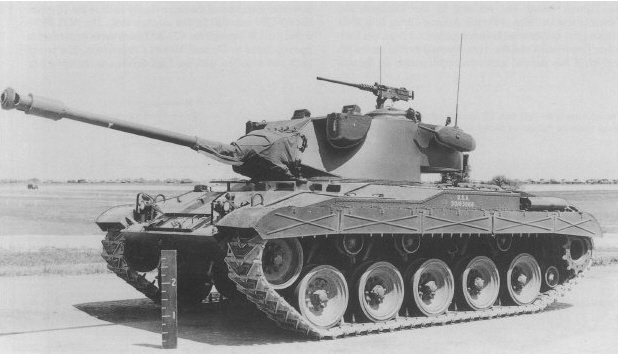
Due to the many differences in the turret design of the T37 Phase II, it re-designated as the T41. Prototype production began and the first vehicle was ready for testing during 1949. Due to the high production cost, the turret was redesigned eliminating the complex optics, range finder and the turret machine gun pods. The commander’s cupola was relocated to the right side of the turret. The resulting T41E1 had a more sleeker look with better ballistic protection and it was put into series production designated as the M41 in 1951.
Originally, the T41E1 received the nickname the “Little Bulldog” which did not follow the US Army normal practice of naming tanks after famous deceased US generals. The name was later changed to the “Walker Bulldog” in honor of General Walton Harris Walker who was the commander of the US 8th Army in Korea. Walker was killed on 23 December 1950 in the Dobong District, Seoul (near Uijeongbu) when his north bound command jeep collided with a south bound South Korean (ROK) weapons carrier (probably a WC-51/52) which swung out of its lane. In Korea, Walker was a Lieutenant General (3 stars) and he was posthumously promoted to full General (4 stars) on 2 January 1951. During WWII, Walker commanded the US XX Corps of Patton’s US 3rd Army in the ETO.
Main Variants:
M41: Standard production model from 1951 to 1952. Armed with a M32/T91E3 76mm rifled gun on an M76/T138E1 mount and carried 57 rounds. Turret traverse was conducted through a pulsing relay system and electrical drives and the tank was powered by an AOS-895-3 petrol engine.
M41A1: Replaced the base M41 as standard production model. Armed with a M32A1 76mm rifled gun on an M76A1 mount and carried 65 rounds. It had a hydraulic turret traverse system.
M41A2: New hydraulic turret traverse system with direct mechanically linked control of the oil gear pump. It had a new AOS-895-5 fuel injection engine, dual power traverse for the tank commander, and a pinion-type gun elevation gear.
M41A3: Final production model functionally identical to the M41A2 but incorporated a slightly modified gun traverse and elevation system.
The M41 chassis was used for the M75 APC, M52 105mm SPH, M44 155mm SPH and the M42 Duster. The M42 Duster armed with twin 40mm Bofors AA guns was used by the US Army in Vietnam.

Film: M41 WALKER BULLDOG ON PARADE
Walk around 1: M41 WALKER BULLDOG
Walk around 2: M41 WALKER BULLDOG
Some sources state that the M41 saw limited combat with the US Army in the Korean War. It is possible the M41 was sent to Korea during the last months of the war for trials or after the armistice was signed but there is no photographic evidence. The M41 quickly replaced the M24 Chaffee in US Army front line units and all of the first production vehicles were sent to NATO units in Europe which at the time were facing the massive USSR armies behind the iron curtain where tensions have been increasing steadily since the Berlin Airlift in 1948.
These M41s with US troops are taking part in a training exercise in an European town in the 1950’s. Note the wooden blocks stored on the front hull which were used to prevent the tank from rolling when parked.

Film: M41 Walker Bulldog — U.S. light tank
Bay of Pigs
During the 1950’s, Fidel Castro led a revolution in Cuba and on 1 January 1959 President Fulgencio Batista fled Cuba allowing Castro to take control. The pre-revolutionary army was disbanded and the new revolutionary army (Spanish: Fuerzas Armadas Revolucionarias – FAR) was formed. The USA considered Castro’s new socialist regime a threat to security in region and the Central Intelligence Agency (CIA) formed an infantry brigade of about 300 anti-Castro Cuban exiles to be used for an invasion to overthrow Castro. During training, Carlos Rodriguez Santana was killed in a training accident and in his honor the brigade was named after his serial number – Brigade 2506. For armor support, the CIA obtained five M41 tanks and the tank training for the brigade’s tank crews took place at Fort Knox, Kentucky, and at Fort Benning, Georgia.
On the morning of 17 April 1961, Brigade 2506 landed at Playa Girón (code-named Blue Beach) and at Playa Larga (code-named Red Beach) on the south coast of Cuba. Four landing Craft Vehicle Personnel (LCVP), three Landing Craft Utility (LCU) and one Landing Craft Mechanized (LCM) transported ashore the five M41 tanks, ten 2 1/2 ton trucks with trailers carrying ammunition and supplies, one bulldozer with a crane attachment, six jeeps, one water trailer (“water buffalo”), and a 7000 gallon tanker truck filled with aviation fuel.
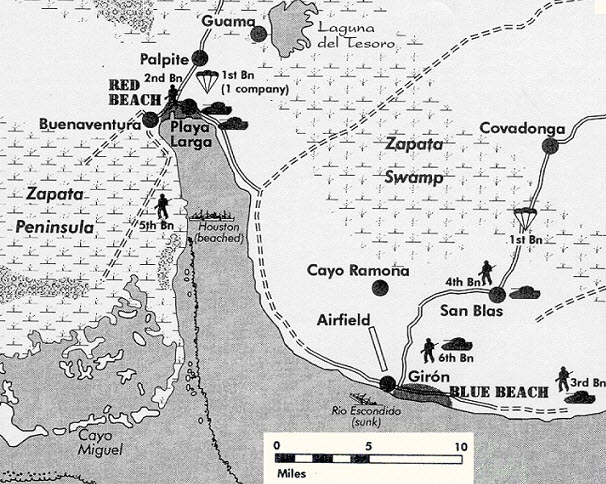
By noon, hundreds of Cuban militia cadets cautiously advancing on foot south towards Playa Larga had suffered many casualties during air attacks by CIA purchased B-26Bs. At 1430 hours, a group of militiamen from the Cuban 339th Infantry Battalion set up a defensive positions came under attack from the brigadista M41 tanks which inflicted heavy losses on the Cubans. The force at Red Beach came under repeated counter-attacks from the Cuban Army and militia and the brigadistas managed to repel the attacks. That night at 2000 hours, Castro opened fire with his 76.2mm and 122mm artillery guns on the brigadista forces at Playa Larga. The brigadistas having intercepted a Cuban radio broadcast learned that the Cuban forces were being reinforced by 40 tanks and in response they deployed their bazookas teams to the front lines closest to the road. At 2355 hours, the Cuban artillery fire stopped after firing over 2,000 rounds which were not very effective due to the long narrow front and the brigadistas entrenched positions. Then a column of T-34/85 tanks rolled through the crossroads. The M41s firing from fixed positions knocked out the first two T-34s. When a third T-34 maneuvered around the two knocked out T-34s, a M41 rammed it and backed away. The M41 then fired at point-blank range at the T-34 damaging its track which forced it to withdraw. By 0020 hours on the 18th, the narrow road was blocked with burning T-34s which prevented the other T-34s to advance. At 0100 hours, Cuban Infantry assaults began. Despite the Cubans taking heavy losses, the brigadistas ran short of ammunition and the T-34 tanks made their way around the burning tanks and continued the assault. At 0545 hours, a T-34 rolled into the crossroads but it stopped then its driver got out and surrendered. He stated that he wanted to join the brigadistas (probably not a wise decision or just bad timing). Around 0900 hours after their ammunition was exhausted, the brigadistas mounted their remaining trucks and retreated south to Playa Girón. At Playa Girón, there was a small amount supplies left and no reinforcements. The Brigade held out for the rest of the day while Castro’s forces closed in and on April 19 the survivors of Brigade 2506 surrendered or were captured. This failed coup only fueled the existing tensions between Cuba and the USA. About 18 months later the next event went to the next level – the Cuban Missile Crisis.
This is one of the knocked out FAR T-34s from the engagement.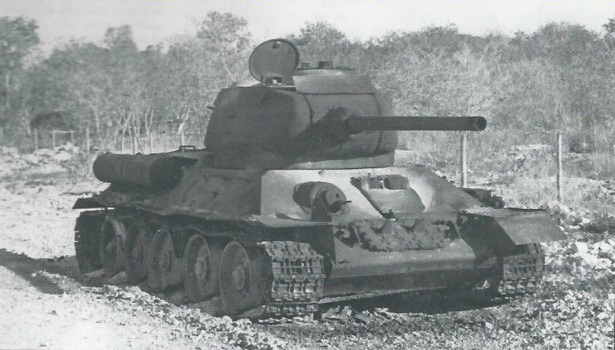
This is the T-34 with the damaged track pushed off the road near the crossroads.
Note the storage hung on the rear of the turret.

This is one of the M41s abandoned on the beach at Playa Girón after the battle.
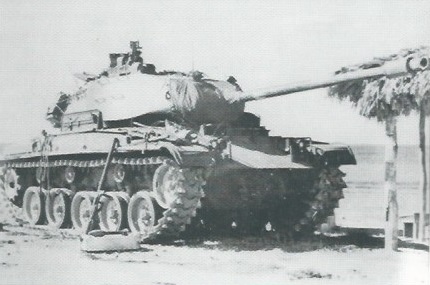
Castro personally led the forces in repelling the invasion and is seen here riding in
his SU-100 on the beach at Playa Girón.

See time 12:23 in this film: The Bay of Pigs video from the Cuban museum
Film: Museo Giron (The Bay of Pigs Museum at Giron) Cuba
South Vietnam
In September 1964, the US Army provided the Army of the Republic of Vietnam (ARVN) also known as the South Vietnamese Army (SVA) M41A3 tanks to replace their aging M24 Chaffee tanks. Training in the use of the M41A3 tanks was conducted from February to December 1965 and the first five M41A3 troops of a new armored regiment became operational. Their first action was in October 1965 when a M41 Squadron of 15 tanks was part of the relief force to break the siege of the Plei Me Special Forces camp in the Central Highlands. After this action, the US role in the war increased dramatically while the role of the ARVN decreased.
An M41A3 of 1st Squadron, 5th Armored Cavalry Regiment (ACR) advances
through the streets of Da Nang during the Buddhist Uprising, May 1966.
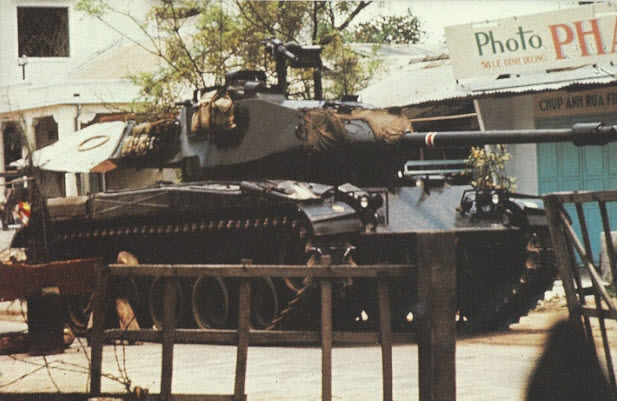
Film: Buddhists Roam in Saigan and DaNang newsreel archival footage
Film: ARVN soldiers, M113 APC and tanks on streets of Saigon.
An M41A3 on patrol near Pleiku in the Central Highlands, 1967.
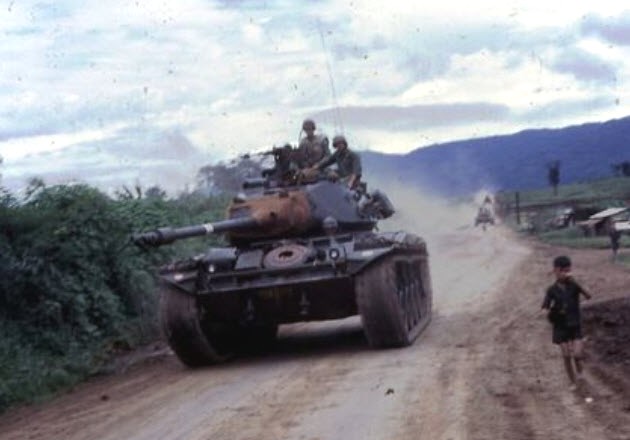
Tet Offensive, 30 January 1968
On the first day of the Chinese New Year, the Year of the Monkey, the People’s Army of Vietnam (PAVN) and the Viet Cong (VC) attacked all military and civilian command and control centers throughout South Vietnam. This Offensive damaged America’s faith in the war and sparked the anti-war movement in the USA. Although the North Vietnamese suffered heavy losses, the war was far from over. CBS anchorman Walter Cronkite, after a brief visit to Vietnam, solemnly informed his viewers that the war was unwinnable.
ARVN M41A3s of the 3rd Armored Brigade moving through Saigon supporting ARVN Marines and Rangers.
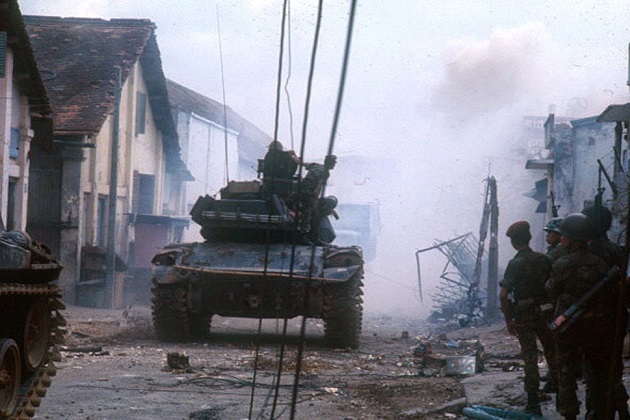
A M41A3 in a storefront. Is this building camouflage or building armor?

An ARVN M41A3 knocked out in the Saigon, February 1968.

18 February, Saigon; 12 year old photographer Lo Manh Hung wanders among refugees near this M41A3 looking for photo possibilities. Note that the M41A3 is missing a section of the front fender.

During the early morning hours of 4 May, communist units executed the second phase of the offensive known by the South Vietnamese and US as “Mini-Tet” by striking at 119 targets throughout South Vietnam, including Saigon.
This M41A3 stands guard in the outskirts of Saigon, May 1968. An unusual feature on this tank was the AN-VSS-1 searchlight mounted above the 76mm gun. This searchlight is the type which was mounted on USMC M48 Patton tanks.

A pair of M41A3s during the Cholon fighting on Confucius Boulevard, Saigon, 1 June 1968.
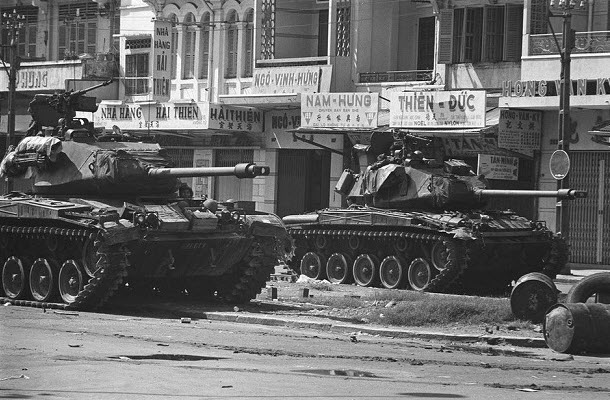
Film: SYND 9 6 68 SAIGON CHOLON FIGHTING
A M41A3 crushed a car as the tank moves through the war-weary Cholon section of Saigon, 3 June 1968.

Another M41A3 travels along the same street. Note the same crushed car.

A M41A3 at the bridge near the Newport docks in Saigon. Note the canvas cover mounted over the turret to provide the crew shade from the hot sun. The driver is lying in a hammock hung between the tracks on the lower front hull.

A pair of M41A3s with interesting shaped canvas covers over the turrets.
A MP M151A1 MUTT is parked beside them.

A M41A3 parked on a street. Note the crew wearing M1 helmets and
the trooper wearing the red bandana.

This M41A3 of the 1st Armored Cavalry Regiment has an Xenon searchlight and
a gun shield for the tank commander’s machine gun mounted, August 1968.

This is another M41A3 with a Xenon searchlight and a gun shield mounted.

Film: 3D ARMORED CAVALRY (ARVN) ROAD CLEARING OPERATION
A M41A3 of the 5th ARVN Cavalry Regiment opens fire on an enemy position in Bien Hoa, III Corps, February 1969.
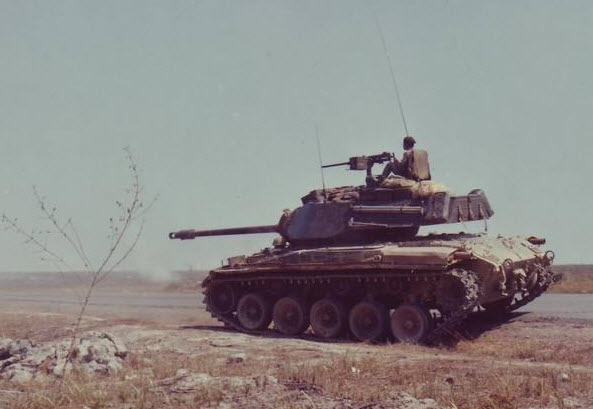
9-10 May 1969, A Company, US 70th Engineer Battalion (Combat), Ban Me Thuot, Khanh Duong (Camp Reil-Davis). Bailey Bridge construction at Bridge 34. The old bridge was blown and a single bailey had been built next to it. They built a double bailey near the single which could support heavier vehicles. They finished the double bailey bridge at 0330 hours after 19 straight hours of work.
ARVN M41A3s provided security and the tanks are fording the river.

This is a view of the single bailey bridge with the ARVN tanks in the background.

A M41A3 crossing a river in Svay Rieng, Cambodia, 27 May 1970.

Film: 22/05/1970 CAMBODIA SOUTH VIETNAMESE TROOPS CLOSE IN ON KOMPONG TRABEK
The 1970 Cambodia incursion was a joint ARVN/US operation.
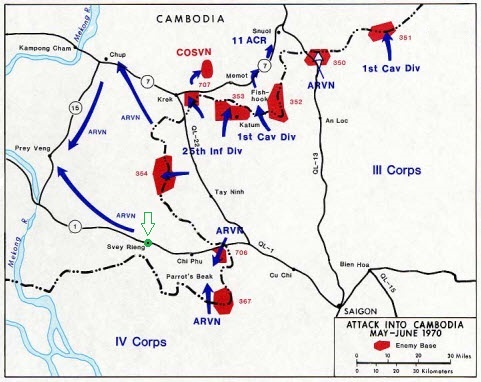
Lam Son 719
This was an offensive campaign conducted in the southeastern portion of the Laos carried out by the ARVN between 8 February and 25 March 1971. The objective of the campaign was the disruption of a possible future offensive by PAVN whose supply routes within Laos were known as the Ho Chi Minh Trail. In preparation for the operation, Fire Support Bases (FSB) were setup on hill tops positions along Route 9 to provide fire support for the surrounding infantry units and the advancing main column. For each FSB, a 15,000 Lb bomb was dropped set to detonate above ground to clear a landing zone in the jungle. Then ARVN airborne troops with 105mm Howitzers and supplies were airlifted by helicopter to the landing zones. The main column started from around Khe Sanh traveled west along Route 9 into Laos. The US provided logistical, artillery and air support for the operation but US ground forces were prohibited by law to enter Laos.

ARVN M41A3s moving west along Route 9 pass Lang Vei enroute to the Laotian border. Note the color air recognition panel draped over the turret.
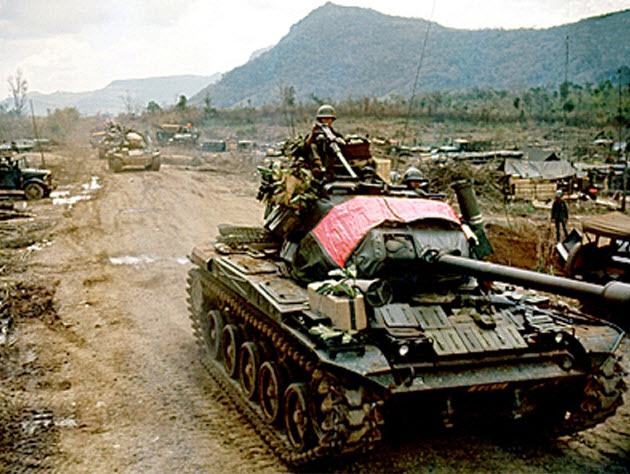
ARVN units gathered at the Vietnam/Laos border for the operation.
Note the US M551 Sheridan tank in the background providing fire support.

M41A3s with foliage carrying ARVN troops advancing west along Route 9.

Film: Operation Dewey Canyon II (24 February 1971) Lam Son 719
Fall of FSB 31
Around noon on 25 February, the ARVN 17th Armored Cavalry Squadron with five M41 tanks and two airborne companies received an order to relieve FSB 31 which was being attacked by massive enemy forces. The relief task force started from A Luoi on Route 9 and advanced northward towards FSB 31.

When the task force reached a dry streambed a few km north of A Luoi, two PAVN PT-76 tanks waiting in ambush opened fire and hit two M113s where one M113 was knocked out of action. The ARVN infantry counterattacked and forced the enemy to withdraw leaving behind one Molotova (GAZ) truck loaded with rice and a PT-76 that was hit but was still operable.
The 17th Cavalry brought the PT-76 back to A Luoi as a war trophy.

That same afternoon while the USAF was supporting FSB 31, a US F-4 Phantom jet was shot down. US focus was switched to rescuing the ejected F-4 crew which was completed between 1700 and 1800 hours that afternoon. Then it began to rain heavily and due to high winds and poor visibility, the task force had to halt where it was. The task force lost contact with the paratroopers defending FSB 31 around 2200 or 2300 hours that night. Due to the ambush, the task force changed its axis of advance and used a DC-4 bulldozer to cut a new road towards FSB 31. Cutting through the jungle took a great amount of time and the 17th Cavalry finally reached FSB 31 at 1700 hours on 26 February. By the time the relief force reached a hilltop about 400 to 500 meters southwest of FSB 31, the sun had began to set and the relief force setup camp for the night.
Early morning of 27 February, ARVN troops on the adjacent hill looked across to FSB 31 which appeared deserted. There was some troop movement but it was not clear if they were friendly or enemy troops. As a test, the M41 tank platoon fired a 76mm round into FSB 31 and the troops inside the base immediately threw out a yellow smoke marker which indicated friendly troops but the squadron commander requested that brigade HQ to confirm this. As the brigade confirmed that the enemy had captured FSB 31, the task force spotted a company of PAVN tanks moving from the northeast towards the 17th Armored Squadron’s frontline. They were advancing in line formation heading straight at the position held by the M41 tank platoon. The order was immediately given to the M41s to fire directly at the lead T-54 tank. The first 76mm round penetrated the T-54’s weak point which blew the tank over onto its back and it burst into flames. Then the other PAVN tanks were systematically knocked out by 76mm fire from the M41 tanks in dug-in positions. By 1300 hours, all five PAVN tanks were destroyed. About an hour later, another tank battle occurred and the rest of the PAVN tanks at FSB 31 were knocked out by the M41 tank platoon of the 11th Armored Cavalry Squadron. As soon as the enemy shelling ended, observation aircraft reported about 15 more PAVN tanks advancing from the northeast to southwest into the battle area as reinforcements. A request was sent to HQ to order a fire concentration on these tanks but instead a flight of B-52s were redirected to carpet bomb the area. The B-52 bomb runs destroyed most of the tanks and the remaining tanks turned around and fled back north. A total of 17 PT-76 tanks, 6 T-54 tanks and 2 Molotova trucks were destroyed on or around FSB 31.
Wounded ARVN troops are being carried along Route 9.
Note the knocked out T-54 in the background.
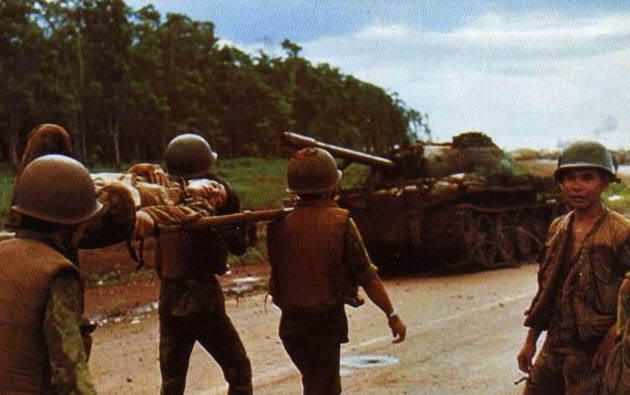
This ARVN armor victory was short lived. The PAVN succeeded in taking FSB 31. Three T-54 tanks reached the perimeter of the base opening the way for the infantry to overrun the base. These PAVN troops are advancing towards a knocked out M41A3 which was probably knocked out by artillery fire.

After reaching Techepone and facing mounting losses due to the superior PAVN armor and bad weather which prevented US air support, the commander of the ARVN forces decided to cut short the operation and ordered a withdrawal back to Vietnam to start on March 9.
Due to FSB 31 and 30 being overrun, the northern flank of Route 9 was exposed. At 0730 hours on19 March, an 18 vehicle convoy was withdrawing east along Route 9 without any air cover. The column was ambushed at a stream crossing about 4 km east of Ban Dong where the PAVN attacked the head of the column being led by four M41s of the 11th Armored Cavalry Squadron and three M113 APCs. All the armored vehicles were towing 105mm howitzers which made it difficult for them to repel the attackers. The damaged vehicles were left across the road blocking all movement on Route 9 while the ARVN crews and troops fled eastward.
These M41A3 were captured by PAVN troops during the withdrawal.


Reports stated that the ARVN went into Laos with 62 tanks and 162 M113 APCs and afterwards returned with only 25 tanks and 64 M113s.
The 1972 Easter Offensive
This was a major PAVN operation launched against ARVN and US forces between 30 March and 22 October 1972. The US policy of Vietnamization, or turning the war over to South Vietnam, was progressing as many US units had left Vietnam. ARVN units manned the frontline along the DMZ with the US providing advisors along with logistical and air support. The ARVN 20th Tank Regiment was equipped with 54 war weary M48A3 Patton tanks but there were problems such as the lack of spare parts and a language barrier between US instructors and Vietnamese tank crews. Translating technical manuals was difficult when terms like ‘Ballistic computer’ was translated to ‘adding machine’ in Vietnamese.

Film: ARVN at An Loc, north of Saigon, 13 April 1972: L’ARVN au combat à An Loc
M41A3s of the 1st Armored Brigade belonging to the 7th or 11th Armored Cavalry
regiment in positions along the Meiu Giang River near Dong Ha.

After holding a defensive line along the Dong Ha River for more than week, the ARVN 1st Armored Brigade was finally outnumbered and forced to withdraw to the south. The PAVN captured this M41A3 of the 11th ACR near the town of Dong Ha on 19 April 1972.

This M41A3 is seen during the withdrawal. Note the armored plate on the turret side.
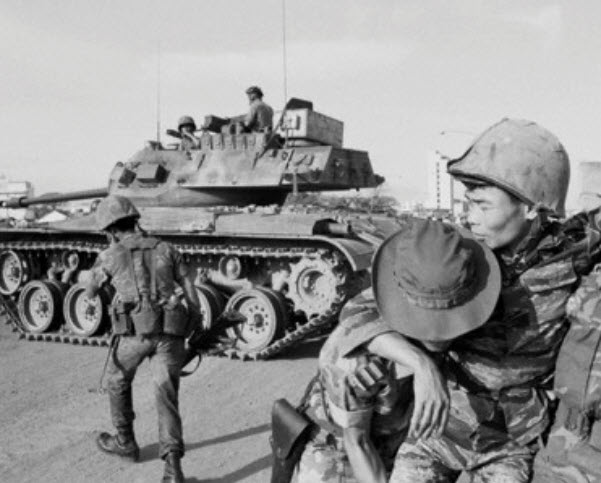
Map of the central front along the DMZ.

Early morning on 23 April 1972, a M41A3 of the 19th Armored Cavalry Squadron parked near the main gate of the Tan Canh base camp was destroyed by munitions which penetrated the tank. The tank crew thought they were hit by a B40 rocket fired by a RPG-2 beyond the defensive wire. The US advisors did not think it was possible because the B40 only had an effective range of about 100 meters and the enemy was more than 500 meters from the tank. The advisory section confirmed that it was a new type of rocket controlled by wires with a maximum range of 2,500 meters and able to penetrate 400mm of armor. That day was the ARVN first encounter with the Soviet-built missile, the 9M14 Malyutka, meaning “little one” which was designated by NATO as the AT-3 Sagger. This was some 18 months before their use against the Israelis during the Yom Kippur war . By that afternoon, five of the M41A3s in the base and several bunkers were destroyed by the missiles.
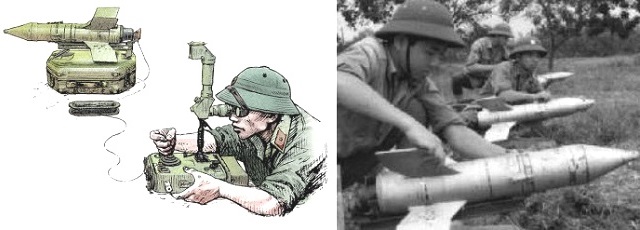
At 0300 hours on 24 April, 1st troop, 2nd Platoon, ARVN 1/14th Cavalry Squadon had five M41s at Ben Het and were ordered to move to Tan Canh to engage the enemy. At the last minute, one tank with engine problems was left behind. The four remaining tanks without infantry support traveled along Route 512 towards Tan Canh. En route another tank beame disabled but the crew was able to repair it and returned to Ben Het. The remaining 3 tanks continued but then ran into an ambush. After a fierce battle, the tank platoon was forced to retreat back to Ben Het.
Around 0630 hours, the communists penetrated the defense lines northeast of Dak To II with tanks and supporting infantry. At the same time approximately one PAVN battalion and a platoon of T-54 tanks attacked the northwest perimeter. After receiving orders from the troop commander, the 3/1 M41 tank platoon at Dak To II moved to the north end of the Phuong Hoang Airfield and engaged the enemy. After this the platoon lost communication with the company. Two T-54 tanks advanced onto the airfield and then split in two directions. One went to the west side of the airfield, blocking the route for ARVN reinforcements coming from Ben Het. The other T-54 went north into the middle of the airfield attacking the ARVN 47th Infantry Regiment defense positions. Immediately two M41s from the troop moved up and fired, each M41 firing three rounds of 76mm into the side of the T-54. The T-54 was hit and burst into flames but it was not stopped. The T-54 with thick armor quickly recovered and counterattacked, knocked out one M41 with two 100mm rounds and then it immediately destroyed the second M41 with a third shot. Afterwards, the PAVN crew abandoned their T-54 and left the area.
From Vietnamese source (translated):
The PAVN tank platoon consisting of three T-54s (numbers: 377, 354, 369) and one self propelled ZSU57-2 number 472 was ordered to move to Dak To II. Route 18 connecting Tan Canh and Dak To II was damaged which made maneuvering very difficult and the distance between the tanks widened. T-54 number 377 was the first tank to reach Dak To II and engaged the two M41s. At the same time, tanks 354 and 369 attacked the ARVN infantry but were later knocked out by US aircraft. It is not known exactly how many victories tank 377 scored that day, but after the battle nine M41s were left behind, in which seven of them were around tank 377. The crew of tank 377 died valiantly in a car on 1 May 1972 (probably during a US air attack).
Tank number 377 abandoned at Dak To II on 24 April 1972.

Tank 377 at Dak To – Tan Canh Victory Monument (Dak To district, Kontum)
The plague describes the historic battle as being “1 against 10”.
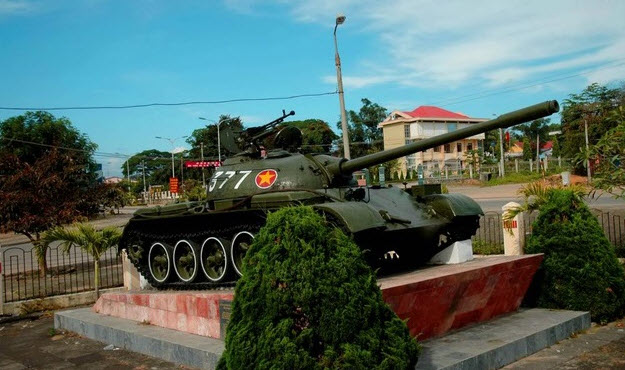
Film: SYND 1-5-72 BATTLE ALONG HIGHWAY ONE
During the1972 Easter Offensive, the PAVN took heavy armor losses from US air attacks which saved South Vietnam from being overrun. Throughout 1973 and 1974, the PAVN had to rebuild and reorganize their armor forces.
A large number of surplus M41s were rushed from the USA to Vietnam to replace the ARVN losses. This Lockheed C-5A Galaxy cargo plane is unloading this M41A3. Note the shipping crates on the engine deck which carry spare parts and external fittings for the tank.

ARVN 1st Armoured Brigade with Airborne and Marine Divisions recapture Quang Tri on 16 September 1972.
Film: ARVN M41A3 tank in Operation Lam Son 72
Similar to the US in Germany 1945, the ARVN began to add sandbags to some of their M41A3s as protection against PAVN hollow charge AT missiles. The US soldier standing beside this M41A3 is probably a US advisor.
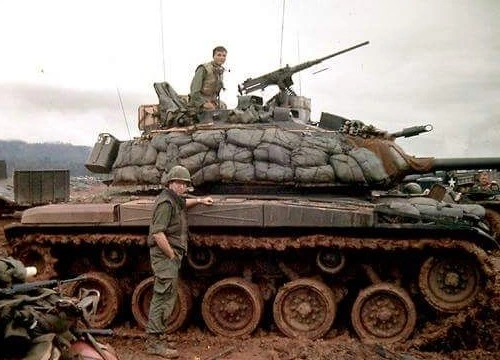
This M41A3 with sandbags traveling along a road. Note the coiled barb wire along the side of the road.

This is another M41A3 with sandbags on patrol.

In January 1973, the US, North and South Vietnam, and the Vietcong signed a peace agreement in Paris, ending US military involvement in the Vietnam War. Even before the last US troops departed Vietnam on 29 March 1973, the communists violated the cease-fire agreement and by early 1974 full-scale war between Northand South Vietnam had resumed.
M41s on a road following a little girl on a bike escaping near Lai Khe, 1973.

A South Vietnamese ice cream vendor on bicycle does business with a trooper riding a M41A3 tank which is part of a tank column moving to intercept a PAVN infantry unit 25 miles north of Sagon, 1973.
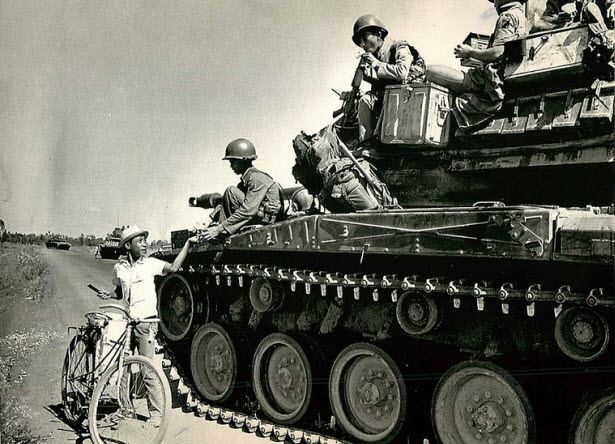
The Fall of South Vietnam 1975
The 1975 Spring Offensive was the final curtain call for South Vietnam where the ARVN was completely alone without any US support. The ARVN had about 300M41A3s but due to a lack of ammunition, spare parts and fuel they were either abandoned, captured or destroyed.
The PAVN captured many ARVN tanks and vehicles supplementing their advancing units. These are seen on parade during the fall of Saigon on 30 April 1975. Later Saigon was renamed Ho Chi Minh city.
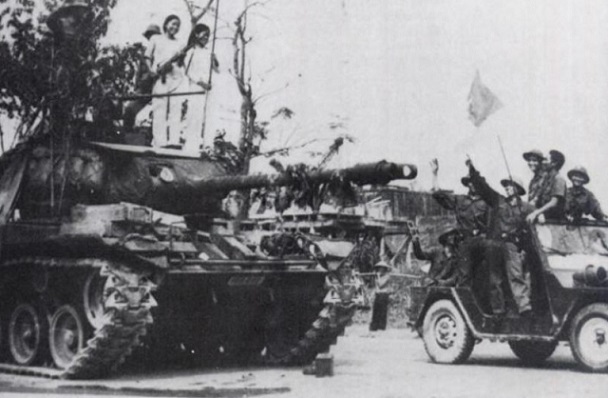

Film: (5-5) Vietnam 1965-1975, as seen on British television.
A destroyed ARVN M41A3 in Ho Chi Minh city, July 1975. A grim war reminder.

M41s in Movies, Documentaries and on US Television.
(This is only a partial list.)
- To Hell and Back, 1955
- Combat! TV series, 1962-1967
- Red Beach, 1967
- Tobruk, 1967
- Patton, 1970
- Raid on Rommel, 1971
- Apocalypse Now, 1979
- From Hell to Victory, 1979
- The Killing Fields, 1984
- Full Metal Jacket, 1987
- Warlords, 1988
- Diên Biên Phu, 1992
- Mars Attacks!, 1996
- Extreme Machines, 1997
- Vietnam in HD, 2011
- Detroit, 2017

I really like your writing style, superb information, thanks for posting : D.
LikeLike
The M41 was not amphibious or treated NBC, but this was not seen as a problem given the fact others contemporary MBTs were not either. The M551 Sheridan tried to respond to these limitations with an NBC, amphibious aluminum alloy hull which solved the weight issue as well as an innovative missile cannon system to compensate for the firepower issue. However, this model had troubles of its own. Foreign upgrades addressed many of the issues listed above which allowed to keep it in service until recently or up to this day.
LikeLike
Please let me know if you’re looking for a writer for your site. You have some really good articles and I think I would be a good asset. If you ever want to take some of the load off, I’d absolutely love to write some articles for your blog in exchange for a link back to mine. Please blast me an email if interested. Kudos!
LikeLike
What a stuff of un-ambiguity and preserveness of valuable experience concerning unexpected feelings.
LikeLike
Appreciating the persistence you put into your site and detailed information you present. It’s great to come across a blog every once in a while that isn’t the same out of date rehashed material. Excellent read! I’ve bookmarked your site and I’m adding your RSS feeds to my Google account.
LikeLike
Like!! I blog frequently and I really thank you for your content. The article has truly peaked my interest.
LikeLike
This is some really solid compiling of information on the M41. Congratulations.
LikeLike
I am really delighted to glance at this weblog posts which includes tons of valuable data, thanks for providing these information.
LikeLike
Do the upgraded Brazilian and Dutch Walkers have upgraded armor? I’m unable to find this info online
LikeLike
I think that the bulldog in the 11th picture for the tet offensive may be an ARVN vehicle because the ARVN used the bulldog heavily and i’ve seen many photos of ARVN troops wearing red bandanas. Anyway I love this website.
LikeLike
1 point: Photo of ARVN M41A3, Saigon , May 68 , does not have an AN/VSS-1 searchlight. It is the older, round Crouse-Hinds 18 inch light, Was used on M46s and M48s before the AN/VSS-1 came into service.
LikeLike